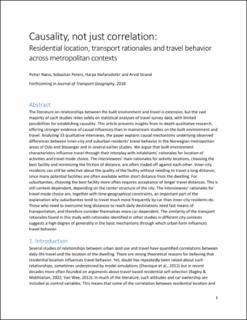| dc.contributor.author | Næss, Petter | |
| dc.contributor.author | Peters, Sebastian | |
| dc.contributor.author | Stefansdottir, Harpa | |
| dc.contributor.author | Strand, Arvid | |
| dc.date.accessioned | 2021-12-08T13:13:49Z | |
| dc.date.available | 2021-12-08T13:13:49Z | |
| dc.date.created | 2018-04-03T20:37:53Z | |
| dc.date.issued | 2018 | |
| dc.identifier.citation | Journal of Transport Geography. 2018, 69 181-195. | |
| dc.identifier.issn | 0966-6923 | |
| dc.identifier.uri | https://hdl.handle.net/11250/2833368 | |
| dc.description.abstract | The literature on relationships between the built environment and travel is extensive, but the vast majority of such studies relies solely on statistical analyses of travel survey data, with limited possibilities for establishing causality. This article presents insights from in-depth qualitative research, offering stronger evidence of causal influences than in mainstream studies on the built environment and travel. Analyzing 33 qualitative interviews, the paper explains causal mechanisms underlying observed differences between inner-city and suburban residents’ travel behavior in the Norwegian metropolitan areas of Oslo and Stavanger and in several earlier studies. We argue that built environment characteristics influence travel through their interplay with inhabitants’ rationales for location of activities and travel mode choice. The interviewees’ main rationales for activity locations, choosing the best facility and minimizing the friction of distance, are often traded off against each other. Inner-city residents can still be selective about the quality of the facility without needing to travel a long distance, since many potential facilities are often available within short distance from the dwelling. For suburbanites, choosing the best facility more often requires acceptance of longer travel distances. This is still context-dependent, depending on the center structure of the city. The interviewees’ rationales for travel mode choice are, together with time-geographical constraints, an important part of the explanation why suburbanites tend to travel much more frequently by car than inner-city residents do. Those who need to overcome long distances to reach daily destinations need fast means of transportation, and therefore consider themselves more car-dependent. The similarity of the transport rationales found in this study with rationales identified in other studies in different city contexts suggests a high degree of generality in the basic mechanisms through which urban form influences travel behavior. | |
| dc.description.abstract | Causality, not just correlation: Residential location, transport rationales and travel behavior across metropolitan contexts | |
| dc.language.iso | eng | |
| dc.title | Causality, not just correlation: Residential location, transport rationales and travel behavior across metropolitan contexts | |
| dc.type | Peer reviewed | |
| dc.type | Journal article | |
| dc.description.version | acceptedVersion | |
| dc.source.pagenumber | 181-195 | |
| dc.source.volume | 69 | |
| dc.source.journal | Journal of Transport Geography | |
| dc.identifier.doi | 10.1016/j.jtrangeo.2018.04.003 | |
| dc.identifier.cristin | 1577061 | |
| dc.relation.project | Norges forskningsråd: 230313 | |
| cristin.unitcode | 192,13,2,0 | |
| cristin.unitname | Institutt for by- og regionplanlegging | |
| cristin.ispublished | true | |
| cristin.fulltext | postprint | |
| cristin.qualitycode | 1 | |
